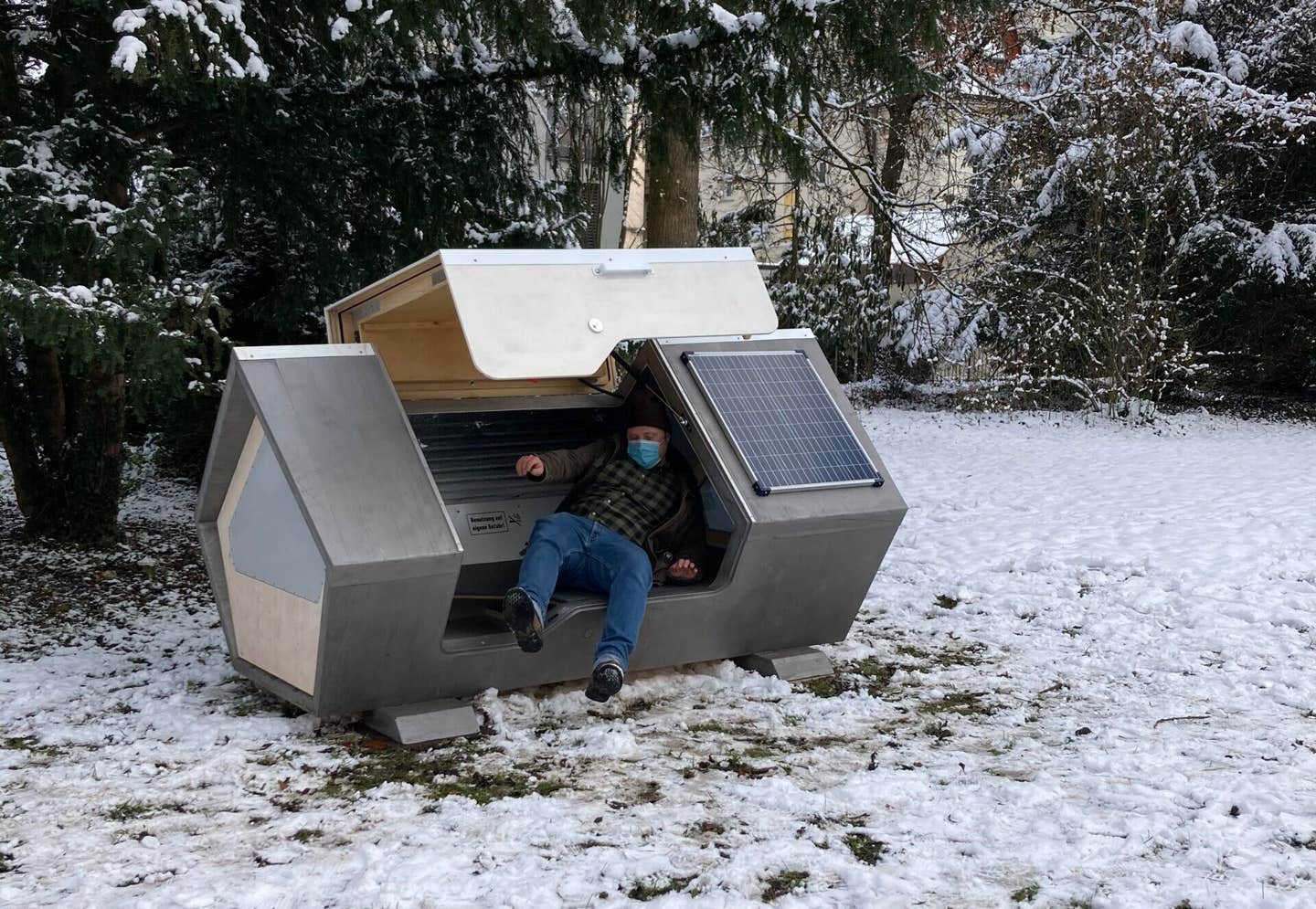Low-cost, smart shelters turn cold nights into safe havens for the homeless
How Germany’s Ulm Nest uses smart design and sensors to keep unhoused people safe during long and cold nights.

 Edited By: Joseph Shavit
Edited By: Joseph Shavit

Test subject entering the Ulmer Nest pod. (CREDIT: Ulmer Nest / Widerstand & Söhne GmbH, bootschaft GbR)
On the cold streets of Ulm, Germany, there is a small wooden pod called the Ulm Nest that's changing the face of how the city provides shelter to its most vulnerable citizens. These insulated capsules, designed to support people through the coldest nights, are more than a place to catch a few winks—they're a lifeline.
Intended to bridge the gap between homelessness and shelter, the Ulm Nest is not an alternative to housing or group shelters. It's a stopgap measure for nights when sleeping outdoors could be deadly. Some have no choice but to avoid traditional shelters due to mental illness, no-dog rules, or the effects of addiction. For them, this pod is safety, warmth, and dignity when there is no other place to go.
Technology Meets Compassion
At first glance, the Ulm Nest looks like a small, futuristic capsule made from wood and steel. But step inside, and you’ll find an impressive mix of warmth, privacy, and technology. Each Nest is built from solid wood sealed to block moisture, paired with powder-coated steel for sanitation and durability. The design is both eco-friendly and cost-efficient—proof that sustainability can go hand in hand with compassion.
Inside, there is real-time monitoring of temperature, humidity, smoke, and carbon dioxide levels by sensors. The data is relayed to a secure app which sends notifications to the city employees if something is wrong. If, for instance, a pod catches fire, emergency responders receive an alert instantaneously. If overnight resident, outreach workers receive automatic alerts to see the guest the next morning.
The system also tracks maintenance needs, cleanliness, and battery life. A ceramic heat exchanger keeps air fresh with warmth contained within, and a replaceable internal battery charges through the night. All made to last—so no one is left shivering in the cold.
From a Castle Workshop to a Citywide Vision
The project started in the most unlikely of places: a castle. Ulm started its "Storm the Fortress" campaign in 2018 to turn the Wilhelmsburg castle into an incubator for local innovators. The Wilhelmsbüro was a result of the project and is made up of design agency Bootschaft, hardware company Widerstand & Söhne, and IT specialist Florian Geiselhart.
When Ulm's Social Services Division made an appeal to the team to come up with a system to protect homeless citizens from hypothermia, the idea of the Ulm Nest was born. They met with emergency shelter staff, the Red Cross, and youth outreach teams to find out what gaps existed in available options. People avoided large shelters due to fear, strict entrance requirements, or mental problems. The group envisioned something between—a private, portable refuge that may be safe without judging.
From Concept to Prototype
The first prototype came together quickly. Using virtual reality, architects asked residents and social workers to step into a virtual simulation of the pod to experience how it would be to live there. That first input led to changes in comfort, accessibility, and design. When the actual prototype was finished, it was made available publicly to citizens and unhoused individuals for further feedback.
Wood was selected for its natural insulation and steel for its sanitary qualities. Although materials such as carbon fiber may emerge later for large-scale production, for now the emphasis is on hand-built, long-lasting, and inexpensive prototypes that can be easily maintained by cities.
Smart Systems for Safety and Care
Aside from its physical structure, the Ulm Nest is supported by an electronic base. Each pod has access to a web-based portal that displays real-time status of occupation, heat, and level of safety. When an individual sleeps in a pod, social workers receive a notification to visit the next day. The visits are usually a gentle reconnection to reintegrate the individuals into services, counseling, or housing plans.
Cleaning or repair alerts are also automatically sent to maintenance teams so the pods remain hygienic and safe. All of this data helps Ulm authorities figure out how often the shelters are being utilized, under what conditions are spurring demand, and how resources can be best allocated in the coming winters.
Fire Safety, Security, and Hygiene
Every aspect of the design was field-tested with the fire department of the city. The employees made certain that the Nests met stringent safety codes and could withstand vandalism, humidity, and freezing. They're built sturdy enough to safeguard individuals both inside and outside.
Cleaning was equally important. The pods can be washed using portable hot-water pressure washers, and crews can sanitize them as often as they wish. These are inexpensive practices that render every Nest secure and welcoming.
Real-World Testing and Community Impact
Prior to the deployment of the initial pods, the city convened everyone involved—police, firemen, social workers, and maintenance personnel—to organize the venture. Outreach workers were instructed on how to notify individuals about when and where the Nests were accessible, stressing that they were to be used only in emergency situations.
Each filled Nest alerts outreach teams, which visit daily to check the health of the occupant and offer support. Technical alerts such as low battery or sensor failure alert the Wilhelmsbüro team to maintenance. Once the trial period is concluded, all data collected will be reviewed to determine whether the project could be expanded or employed as an example for other cities.
Balancing Innovation with Compassion
Other critics are arguing that funds must go into permanent housing, not into small-scale projects like Ulm Nest. But its architects point out that it's not a substitute—its a bridge. As one of the designers explained, "Without concepts like the Ulmer Nest, people would have no cover and would have to sleep outside, even in winter.".
The Nest gives outreach workers a second opportunity to connect with those who all too easily slip through the cracks. It's not glamorizing street living—it's preserving lives and giving hope on evenings when one degree of warmth means all the difference.
The Ulm Nest shows that technology, design, and empathy can work together to solve human needs in new ways. Its sensor network, smart data system, and minimalism could be a model for cities everywhere.
Saving one life at a time is sometimes the greatest innovation of all.
Related Stories
- Mystery Donation of Rare Air Jordans Raises Over $50,000 for Oregon Homeless Shelter
- How light and city design are shaping healthier, happier lives
- Basic Monthly Income and Social Support Transforms Lives of the Homeless, Study Finds
Like these kind of feel good stories? Get The Brighter Side of News' newsletter.
Joshua Shavit
Science & Technology Writer and Editor
Joshua Shavit is a Los Angeles-based science and technology writer with a passion for exploring the breakthroughs shaping the future. As a co-founder of The Brighter Side of News, he focuses on positive and transformative advancements in AI, technology, physics, engineering, robotics and space science. Joshua is currently working towards a Bachelor of Science in Business and Industrial Engineering at the University of California, Berkeley. He combines his academic background with a talent for storytelling, making complex scientific discoveries engaging and accessible. His work highlights the innovators behind the ideas, bringing readers closer to the people driving progress.



